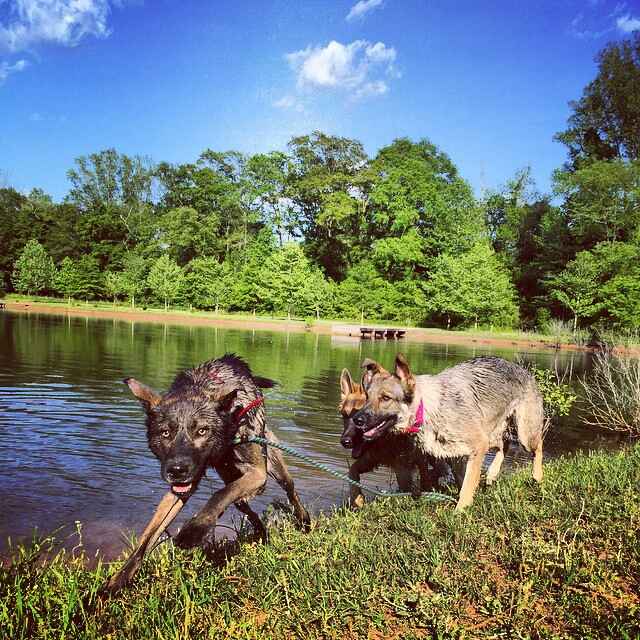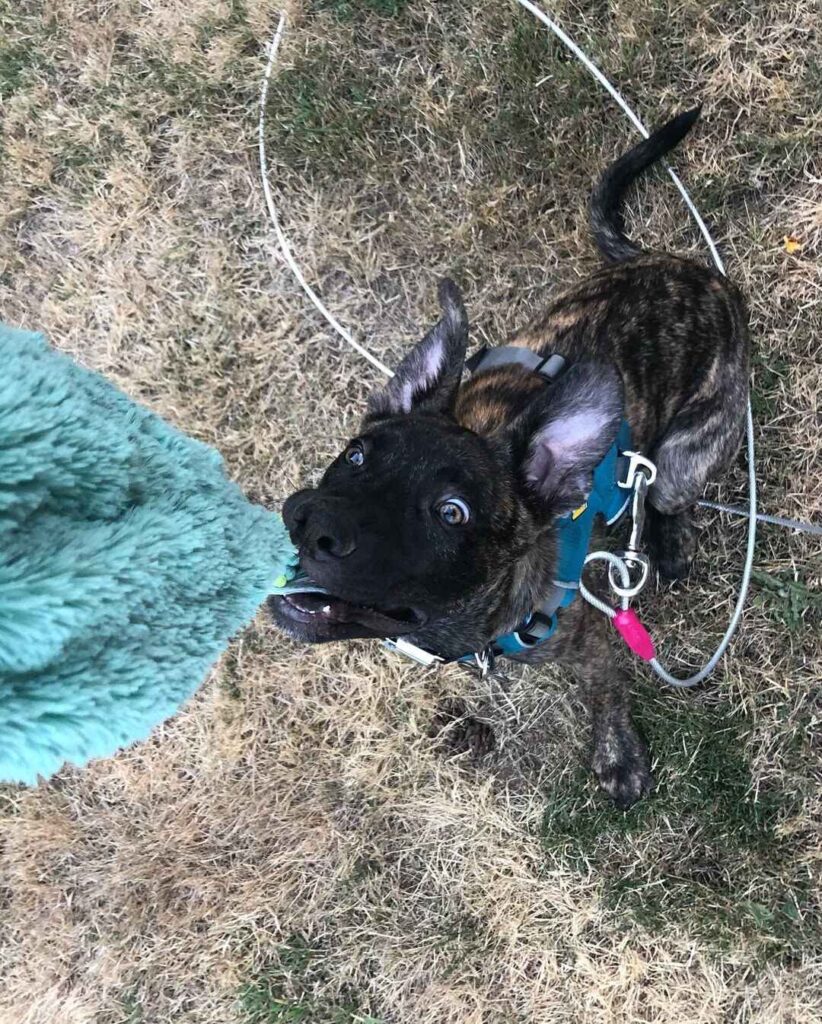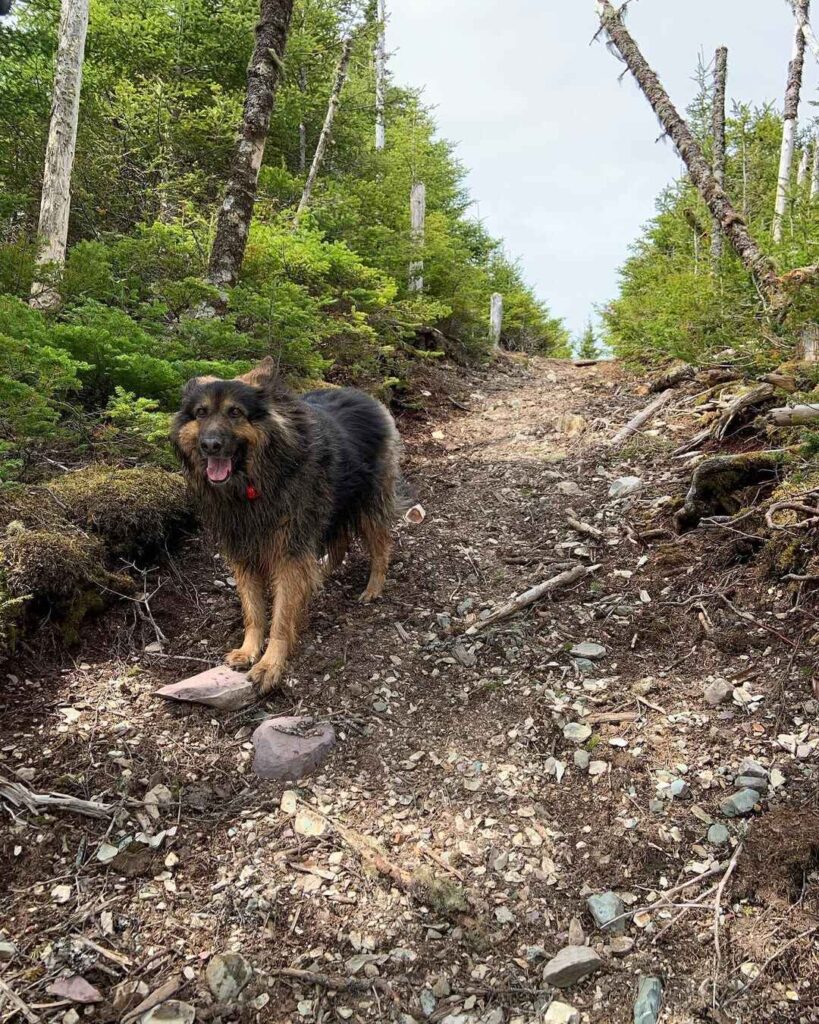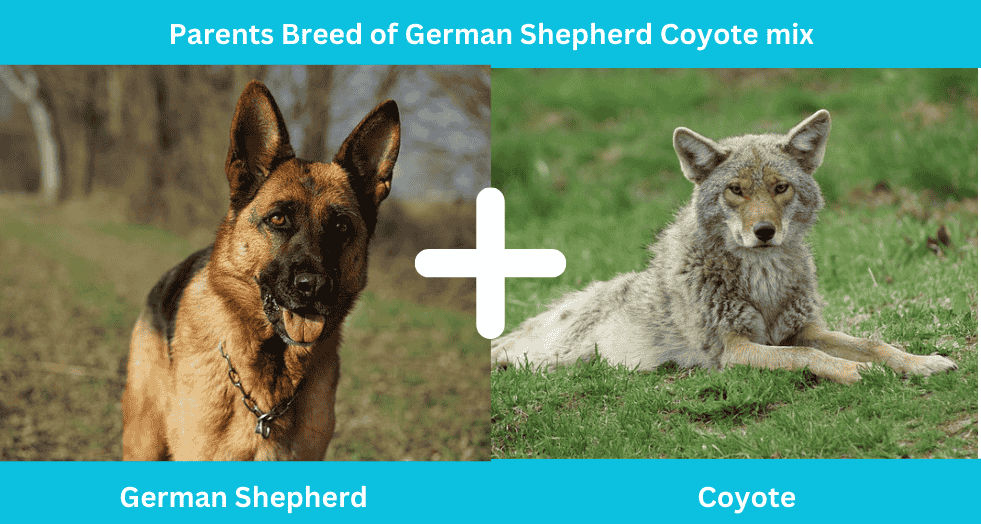The German Shepherd Coyote Mix is one of the most unique hybrid breeds in the dog world. These impressive dogs reach a height of 23 to 28 inches and weigh 85 to 110 pounds. Although it is not naturally found in the wild, this mix has inherited extraordinary intelligence from its German Shepherd parent.
These hybrid dogs need at least an hour of high-energy exercise per day and experienced handlers to thrive. In our experience, they are usually strongly attached to one family member, but their wild instincts can make their behavior unpredictable. This article will help you understand if this unique hybrid fits your lifestyle, whether you are interested in a Coyote German Shepherd Mix puppy, or are considering adoption.
Understanding the Origin of the Coyote German Shepherd

(Photo Credit: Instagram)
The story of the German Shepherd Coyote Mix began thousands of years ago through natural breeding between coyotes and domestic dogs. Black-coated coyotes got their distinctive coloring from dogs that came to North America across the Bering Land Bridge. 12,000 to 14,000 years ago
History of hybridization
Coydog breeding emerged in pre-Columbian Mexico, where the Teotihuacans placed special cultural value on coyotes. These indigenous communities bred coyotes with domestic dogs to create guardian animals that combined domesticated loyalty with wild ferocity. In addition, northern Canadian communities bred coyotes with their sled dogs to create stronger working animals.
Studies have shown that the genetic makeup of eastern coyotes is different from that of western coyotes. These coyotes acquire dog genes from mostly male dogs through asymmetric genetic introgression. The hybrid offspring then re-breed with coyotes. This genetic mixing occurs naturally when coyotes move to new areas where they cannot find other coyotes to mate with.
Why do these mixtures occur?
There are several reasons behind the creation of this unique hybrid species. Both coyotes and dogs belong to the Canidae family, which makes successful breeding possible. However, there are some challenges to natural hybridization. Coyotes mate in the winter, while dogs breed in the spring.
Reproduction occurs in two main situations:
- Coyotes are moving into new territory without other coyotes.
- Where people and dogs live near coyote habitat
Creating a stable coydog population faces significant challenges:
- Male coydogs provide limited care for their young.
- Behavioral traits of wild canids fade over generations
- They hunt less effectively and require additional food.
Recent genetic research confirms that eastern coyote populations carry dog mtDNA haplotypes in their lineages, indicating past interbreeding between female dogs and male coyotes. Studies of the Y chromosome in eastern populations point to more frequent mating between male dogs and female coyotes.
The offspring show an impressive ability to adapt. First-generation hybrids typically share traits from both parents, while second-generation offspring show more diverse characteristics. These hybrids have unique vocalizations that combine the sounds of a coyote howl and a dog bark.
What Makes the German Shepherd Coyote Mix Different?
“Many people know how to play chess, but there are masters, and then there are grandmasters, and I think German Shepherds are the grandmasters of this canine code. Doggy Dan, professional dog trainer and founder of The Online Dog Trainer
The German Shepherd Coyote Mix has unique physical characteristics that set it apart from other breeds. These remarkable hybrids are medium to large. They stand tall at the shoulder and weigh between 60 and 120 pounds. They range in height from 22 to 28 inches.
Physical characteristics compared to purebred German Shepherds
Their sharp eyes are the biggest difference that people immediately notice. These dogs have a face that combines noble features similar to that of a German Shepherd and have triangular, erect ears that come from their coyote parents. Their thick coat can be sable, white, brown, or black.
You’ll notice something special about their gait. Their hind legs angle slightly to the side as they run, like a coyote. Their bushy tail points downward, creating a different shape than the proud, curved tail of a German Shepherd.
Behavioral differences from normal dogs
These hybrid dogs do not behave like typical domestic dogs. They are usually deeply attached to only one member of the family, rather than being friendly with everyone. Although they are more intelligent than many domestic dogs, they often use their intelligence to plan escapes, rather than learning commands.
Their vocalizations are a mix of both worlds. They regularly alternate between a dog bark and a coyote-like howl or howl. These unique sounds remind us of their wild heritage.
Instincts and tendencies
The wild instincts of these hybrid animals come out in many ways. They solve problems creatively and often make detailed plans to achieve what they want. Sudden movements or loud noises startle them easily because they are always on guard.
These dogs are territorial. They mark their territory and are aware of everything around them. They have a keen hunting instinct and a strong tendency to chase small animals.
These hybrids can be incredibly loyal to their families. However, their independent nature usually gets the better of them. They don’t care about typical dog activities like fetching toys or playing. They prefer activities that match their instincts, like scent tracking and exploring new places.
Legal and ethical considerations
strongly oppose owning canine hybrids as pets or for breeding.
State regulations regarding coyote hybrids
Ownership rules vary widely among states. States that allow wolf-hybrid ownership may also allow coydogs. These states include Arizona, Colorado, Indiana, Kansas, Louisiana, Minnesota, Montana, Nebraska, Nevada, New Jersey, New Mexico, North Carolina, Ohio, Oklahoma, Oregon, South Carolina, Tennessee, Texas, Utah, Vermont, Washington, West Virginia, and Wisconsin.
Local laws often place strict limits on hybrid ownership, even in states that allow it. Prospective owners should carefully check both state and city regulations. Public health officials may order these hybrids to be put down after a bite incident, regardless of their vaccination status.
Reproduction restrictions
German Shepherd coyote hybrids face significant legal hurdles. It is illegal to sell puppies from domestic dogs and wild animals, including coyotes, throughout the United States. In addition, several states specifically prohibit:
- Private ownership of wild dogs
- Commercial breeding activities of wild hybrid varieties
- Sale or transfer of these animals between private parties
Professional veterinary organizations have serious concerns about these hybrid dogs. According to AVMA rules, veterinarians must verify the legal ownership of hybrid dogs before accepting them as patients. Rabies vaccinations also pose a special problem because routine vaccinations are not approved for hybrid animals.
These animals face different public health regulations than regular dogs. Officials may order euthanasia instead of the usual quarantine after possible exposure to rabies. Insurance companies generally do not cover cases involving hybrid dogs.
The rules are complicated, so those who want a German Shepherd Coyote mix should first talk to local authorities and veterinarians. This will help ensure that they are complying with current laws and understand their legal responsibilities as owners of this unique animal.
Daily life with a coydog

(Photo Credit: instagram)
A German Shepherd Coyote Mix requires extra attention to meet its special needs. These amazing hybrids require specific care that is different from regular domestic dogs.
Housing requirements
A reliable enclosure is the home for these intelligent creatures. Their coyote background makes them excellent escape artists, so a high fence with a deep base will keep them from digging. These hybrids also need a place, like their own den, where they can hide and feel safe.
Exercise needs
Physical activity is very important for keeping the German Shepherd Coyote healthy in body and mind. This energetic hybrid should include in their routine: 60-120 minutes of exercise per day.
- Vigorous activity like running or swimming
- Mental stimulation through tracking games
- Structured training sessions for behavior management
Without a doubt, a lack of exercise creates destructive behaviors like excessive chewing, digging, and incessant barking.
Feeding habits
These hybrids require a holistic approach to nutrition that respects their wild roots. We have focused on high-quality protein sources for their diet, which should make up about one-quarter of their calories. Rapid food changes can upset their digestion. Slow changes work best if you start with a 75:25 mix of old and new foods.
Social interaction
The social behavior of these hybrids makes them unique. They start shy when meeting new people but form strong bonds with their primary caregiver. They respond better to confident behavior than timid approaches – direct hand-holding can make them defensive.
These hybrid dogs have strong territorial instincts and require early socialization to avoid aggressive behavior. They seem to do better with females, perhaps because female handlers are less intimidating. These dogs need regular companionship because alone time can lead to anxiety and destructive habits.
Training challenges and solutions
Training a German Shepherd Coyote Mix comes with unique challenges that require patience and skill. These remarkable hybrids combine the intelligence of the German Shepherd with the independent nature of the coyote to create a unique training dynamic.
The importance of early socialization
The German Shepherd Coyote Mix’s developmental period and socialization period are critical. During this time, puppies are more open to new experiences and less fearful of unfamiliar situations. Good socialization should include: The first 16 weeks are crucial
- Controlled exposure to different environments
- Positive interactions with different people
- Carefully managed meetings with other animals
These hybrids respond better to confident interactions than to submission. People often make the mistake of letting them sniff their outstretched hands. This behavior can trigger a defensive response because they perceive it as fear or submission.
Dealing with wild instincts
Understanding their unique psychology helps to control their wild instincts. German Shepherd Coyote Mixes are less expressive than typical dogs and are not as quick to follow commands. Traditional reward-based methods can backfire, so they require a different approach to training.
These hybrids work well with:
- Clear, consistent leadership
- Well-organized daily routine
- Activities that channel their natural tracking abilities
These dogs can understand sarcasm, which makes it an effective training tool. They are quick to test boundaries and challenge any leadership they perceive as weak. You can maintain control through firmness without aggression and by enforcing rules.
Physical barriers play an important role in guiding their instincts. Baby gates help control their movements when guests arrive. Puzzle toys and mental challenges effectively redirect their natural problem-solving abilities.
These hybrids form strong bonds with their families but can be aggressive towards fearful people or animals. Their interactions require careful management that focuses on positive experiences with confident handlers.
Healthcare and maintenance

(Photo Credit: instagram)
Caring for the health of your German Shepherd Coyote Mix requires your full attention and regular monitoring. These special hybrids face unique health challenges that require active management.
Common health problems
The biggest problem with this hybrid breed is this disease. This condition causes joint pain and makes it difficult for dogs to move. You will notice that your dog is stiff when standing or walking. They may not come when called. There is another cause for concern – bloat. This often occurs in deep-chested dogs. If this occurs, your dog needs to see a veterinarian immediately. Without treatment, bloat can be fatal in just 30-60 minutes. Hip and Elbow Dysplasia
These hybrids often develop exocrine pancreatic insufficiency. This occurs in two-thirds of dogs with the German Shepherd gene. Dogs with this condition cannot absorb nutrients well. They suffer from malnutrition even when eating regular food. Your puppy may also develop cataracts – sometimes as young as 8 weeks old.
Decoration needs
A well-planned grooming routine is essential to keeping your dog’s coat healthy. Brush their double coat with a soft-bristled brush three times a week. Bathe them every 4-8 weeks. Overwashing will strip their skin of its natural oils.
Your dog’s nails should be trimmed every 3-4 weeks. If they are too long, you will hear the sound of nails scraping on hard floors. Check their ears weekly to check for ear infections or wax buildup before they develop. Don’t forget about dental care – brush their teeth 2-3 times a week.
Veterinary considerations
These hybrids need regular veterinary checkups. During the checkup, your veterinarian should:
- Pay attention to joint health
- Check for parasites
- Update the vaccine
- Get regular health checkups.
What your dog eats affects the health of their coat and the amount of hair they shed. Good protein sources help keep them healthy. Poor food choices can lead to constant shedding. Keep in mind that these hybrids may require special veterinary care. Standard treatments may affect them differently than purebred dogs.
Is this blend right for you?
There are several important things to consider when getting a German Shepherd Coyote mix. These unique hybrids simply require specific living environments and care that are different from regular dogs.
Lifestyle compatibility
The first-generation German Shepherd Coyote mix challenges even experienced dog owners. These hybrids can be destructive when left alone, so they need constant companionship. Most owners spend at least 1-2 hours of physical activity with their pets every day.
A successful partnership depends on:
- During daily mass interaction
- Commitment to continuous training
- Be prepared to adapt your schedule to their needs.
- Knowledge of their wild instincts
Experience requirements
These hybrids require special knowledge and a lot of patience. Their complex behavior confuses even experienced dog handlers. They form strong bonds with one family member but can be aggressive towards those who are afraid.
You should know:
- Pack dynamics
- Subtle behavioral cues
- Regional Instinct Management
- Effective control strategies
Accommodation needs
These active hybrids will need to meet specific requirements in your home. They need a strong, secure enclosure to deter escape attempts. A fenced yard is essential due to their high energy levels and natural roaming instincts.
These mixes find it difficult to adapt to city life due to their natural wariness. Rural or suburban areas work better because they offer more exercise options and mental stimulation. A place like a cave helps satisfy their instincts.
Success with these pets comes through proper boundary setting and clear leadership. They respond best to confident handlers who understand their unique personalities. With proper management and care, they become loyal companions for owners who are prepared to meet their special needs.
Conclusion
German Shepherd Coyote Mixes are fascinating animals that require careful consideration before adoption. Our years of practical experience show that these hybrids combine a keen intelligence with wild instincts. If you are the right owner, they can be unique companions.
These dogs require dedicated owners who cater to their specific needs. Your success with these pets depends on safe housing, regular training, and plenty of daily exercise. In addition, you should check your local laws as the rules for keeping these hybrid dogs vary greatly from region to region.
These hybrids can be difficult to handle but with the right care, they show amazing loyalty and intelligence. They do best with experienced handlers who live in rural or suburban areas with plenty of space. Before bringing one home, make sure you can give these remarkable creatures the special care, time, and space they need to thrive.
Frequently Asked Questions
Question 1. Can German Shepherds breed with coyotes?
While it is technically possible, it is extremely rare in the natural environment. German Shepherd-coyote mixes are not common and usually occur as a result of intentional human breeding rather than naturally occurring in the wild.
Question 2. What are the distinctive physical characteristics of the German Shepherd Coyote Mix?
German Shepherd Coyote Mixes are typically medium to large, standing 22 to 28 inches tall and weighing 60 to 120 pounds. They often have sharp eyes, triangular erect ears, and a thick coat that can range from sable to white, brown, or black.
Question 3. Is a German Shepherd Coyote Mix Legal?
The legality of owning a German Shepherd Coyote Mix varies by location. Many states have restrictions on hybrid ownership and local ordinances may apply. It is very important to research and comply with the rules and regulations in your area before considering such a mix.
Question 4. What are the exercise requirements of a German Shepherd Coyote Mix?
These high-energy hybrids typically require 60-120 minutes of exercise daily. Their routine should include vigorous activity such as running or swimming, mental stimulation through tracking games, and structured training sessions for behavioral management.
Question 5. How does the temperament of a German Shepherd Coyote Mix differ from that of a purebred German Shepherd?
German Shepherd Coyote Mixes often exhibit more independent and potentially unpredictable behavior than purebred German Shepherds. They may form close bonds with one family member, show strong territorial instincts, and require experienced handling due to their wild nature.
